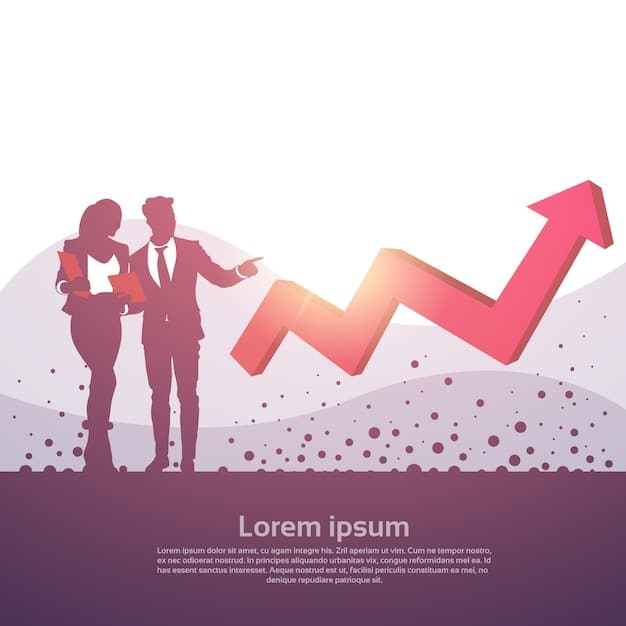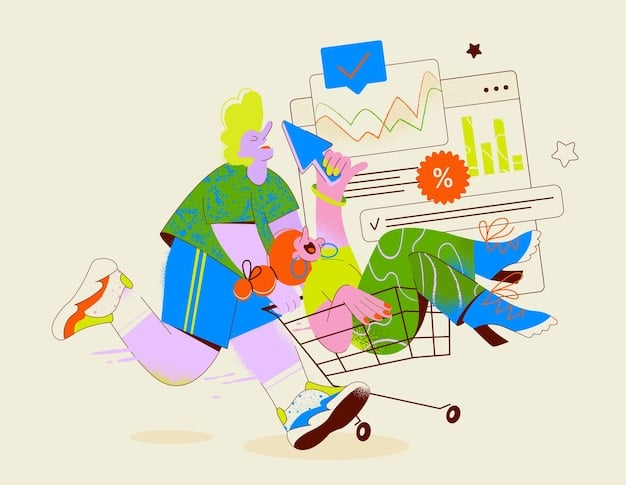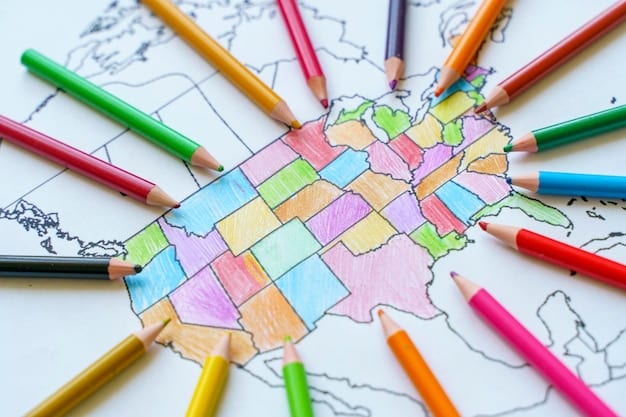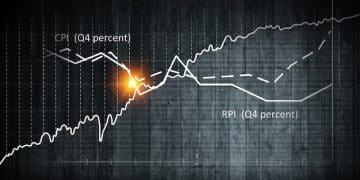US Consumer Confidence Index: Reaches 6-Month High Amidst Economic Optimism

The latest report indicates the US Consumer Confidence Index has surged to its highest level in six months, reflecting a renewed sense of optimism among American consumers about current economic conditions and future prospects, significantly impacting spending and investment behaviors.
A new report: US Consumer Confidence Index rises to highest level in 6 months, sparking discussions across economic sectors. This significant upturn suggests a shifting sentiment among American households, potentially signaling a more robust economic outlook ahead.
Decoding the Consumer Confidence Index: What Each Point Means
The Consumer Confidence Index (CCI) is a critical economic indicator, providing insight into the general sentiment of consumers regarding the economy. Its recent rise to a six-month high is more than just a number; it represents a collective shift in how Americans perceive their financial well-being and the broader economic landscape.
Understanding the CCI Components
The CCI is based on two primary components: consumers’ assessment of current economic conditions and their expectations for the next six months. The current gain indicates improvements in both areas, with consumers feeling more secure about their present jobs and financial situations, and showing greater optimism about future employment, income, and business conditions.
- Current Conditions Index: Reflects perceptions of current business and labor market conditions. A higher reading here suggests consumers feel secure in their jobs and comfortable with their spending power today.
- Expectations Index: Gauges consumers’ short-term outlook regarding income, business, and labor market conditions. An increase in this component points to growing confidence in future economic stability and personal financial growth.
Each point registered on the CCI is meticulously calculated from a nationwide survey, capturing a snapshot of household sentiment. This data is invaluable for policymakers and businesses, serving as a reliable bellwether for consumer spending—a major driver of the US economy. The recent uptick suggests potential for increased discretionary spending and investment, factors crucial for sustained economic expansion.
Key Drivers Behind the Surge in Consumer Confidence
The notable increase in the US Consumer Confidence Index isn’t an isolated event; it’s the culmination of several underlying economic and psychological factors. Understanding these drivers is essential to forecast the sustainability of this positive trend and its potential impact on various sectors.
Economic Tailwinds and Their Influence
Several economic indicators have been trending positively, contributing to the elevated consumer sentiment. A robust job market, with consistently low unemployment rates and steady wage growth, empowers consumers with greater purchasing power and a sense of job security. Furthermore, easing inflationary pressures, though still a concern, have helped alleviate some of the financial burdens on households, stretching their incomes further.
- Strong Labor Market: Continued job creation and declining unemployment signal a healthy economy where individuals feel secure in their employment. This security often translates into higher confidence in future income.
- Moderating Inflation: Although prices remain elevated, the perceived slowdown in the rate of inflation provides a psychological boost. Consumers anticipate their money will retain more value in the near future.
- Stock Market Performance: Often a barometer of economic sentiment, a resilient or advancing stock market can bolster consumer confidence, particularly among those with investments.
These macroeconomic improvements tend to trickle down, influencing individual financial decisions and, consequently, the collective confidence. The perceived stability and opportunities in the economy encourage consumers to feel more comfortable about making significant purchases, such as homes or vehicles, and investing in their future.
Impact on Spending Habits and Economic Growth
When the Consumer Confidence Index rises significantly, its ripple effects are felt throughout the economy, particularly in consumer spending habits. This elevated confidence often translates into a willingness to spend more, invest more, and even take on more debt, all of which are crucial for economic growth.

Shifts in Consumer Behavior
A confident consumer is more likely to open their wallet. This applies to a wide range of purchases, from daily necessities to discretionary items like vacations, cars, and home improvements. Businesses often anticipate this surge and plan their inventories and marketing strategies accordingly.
Moreover, housing market activity often sees a boost. Confident consumers are more inclined to make long-term financial commitments, such as purchasing a new home or refinancing an existing one. This has a cascading effect, stimulating related industries like construction, real estate, and home furnishings.
- Retail Sales Increase: Higher confidence directly correlates with increased shopping activity across all retail sectors, from online stores to brick-and-mortar establishments.
- Investment in Durable Goods: Consumers are more likely to invest in big-ticket items that last, such as appliances, furniture, and vehicles, which drives manufacturing and sales.
- Boost in Services Sector: Spending on services, including travel, entertainment, and personal care, also experiences an uptick as consumers feel more secure in indulging in experiences.
The cumulative effect of these shifts in spending behavior fuels economic growth, contributing significantly to the Gross Domestic Product (GDP). Businesses respond to increased demand by expanding operations, hiring more staff, and investing in new technologies, creating a virtuous cycle of economic expansion.
Challenges and Headwinds on the Horizon
While the recent surge in consumer confidence is undoubtedly positive news, it’s crucial to acknowledge that the economic landscape is never without its challenges. Several potential headwinds could temper this optimism or even reverse the trend if not carefully managed.
Lingering Inflationary Concerns
Despite signs of moderation, inflation remains a persistent concern. Unexpected spikes in energy prices, global supply chain disruptions, or geopolitical events could reignite inflationary pressures. A significant resurgence of inflation would erode purchasing power, forcing consumers to cut back on discretionary spending and potentially undermining their newfound confidence.
- Energy Price Volatility: Fluctuations in oil and gas prices can quickly impact household budgets, affecting transportation costs and utility bills.
- Global Supply Chain Issues: Lingering bottlenecks or new disruptions could lead to product shortages and price increases, affecting availability and affordability.
- Geopolitical Instability: International conflicts or trade disputes can create economic uncertainty, dampening consumer and business sentiment.
Interest rate hikes by the Federal Reserve, aimed at controlling inflation, also pose a risk. While necessary for economic stability, higher interest rates can increase borrowing costs for mortgages, car loans, and credit cards, potentially slowing down big-ticket purchases and overall economic activity. Vigilance is key to navigating these potential pitfalls and sustaining the current positive momentum.
Regional Variations in Consumer Sentiment Across the US
While the overall US Consumer Confidence Index shows a national trend, it’s important to recognize that economic realities and consumer sentiments can vary significantly across different regions. Factors such as local industry strength, housing market conditions, and demographic shifts play a crucial role in shaping regional confidence levels.

Spotlight on Key Regions
For instance, states heavily reliant on technology or manufacturing might experience higher confidence if those sectors are thriving, whereas regions dependent on agriculture or tourism might see fluctuations linked to specific seasonal or global events. The robust job market in some tech hubs, for example, might contribute to higher confidence in the West Coast compared to regions facing industry-specific downturns.
- Northeast: Often characterized by diverse industries like finance and healthcare, sentiment here might be influenced by corporate earnings and employment in professional services.
- Midwest: Manufacturing and agriculture play a significant role. Confidence levels could reflect the health of these sectors, including commodity prices and trade policies.
- South: A rapidly growing population and industries like energy and tourism can drive confidence, but also susceptibility to energy market volatility or travel downturns.
- West: Dominated by technology and innovation, consumer confidence here often mirrors the performance of the tech sector and real estate markets, which can be highly dynamic.
These regional disparities are critical for businesses planning localized marketing strategies and for policymakers addressing specific economic challenges. Understanding these nuances extends beyond the national aggregate, offering a more precise picture of the widespread impact of economic trends.
Looking Ahead: Projections and Future Implications
The recent rise in the US Consumer Confidence Index offers a valuable lens through which to view future economic trends. While past performance is no guarantee of future results, this indicator often provides critical insights into the likely trajectory of consumer spending and overall market dynamics.
Anticipating Market Reactions
Economists and market analysts are closely watching this trend, as sustained high consumer confidence can lead to increased investment and expansion plans for businesses. If consumers continue to feel secure and optimistic, it’s plausible to expect continued strength in retail sales, a rebound in certain service sectors, and potentially even a more active housing market.
- Business Expansion: Confident consumers signal robust demand, prompting businesses to expand production, invest in new assets, and potentially hire more staff.
- Policy Considerations: For central banks and governments, elevated consumer confidence might influence policy decisions, such as interest rate adjustments or fiscal spending, as they navigate economic stability.
- Investment Opportunities: Investors often view strong consumer sentiment as a positive signal for blue-chip companies and consumer discretionary stocks, potentially leading to market upticks.
However, it is also important to consider that consumer confidence can be volatile, reacting swiftly to unforeseen events or shifts in economic data. The projections, therefore, remain cautiously optimistic, with an emphasis on monitoring global events and domestic policy actions that could influence this crucial economic barometer. The next few months will be telling for whether this six-month high signals a long-term trend or a temporary peak.
| Key Point | Brief Description |
|---|---|
| 📈 Confidence Surge | US Consumer Confidence Index hits a 6-month high, reflecting optimism. |
| 💰 Spending Impact | Higher confidence often leads to increased consumer spending, benefiting retail. |
| 💼 Job Market Strength | A strong labor market is a major driver behind the positive consumer sentiment. |
| ⚠️ Future Challenges | Inflationary pressures and interest rates remain potential headwinds. |
Frequently Asked Questions About Consumer Confidence
▼
The Consumer Confidence Index (CCI) is a monthly survey conducted by The Conference Board that measures consumer attitudes and buying intentions. It gauges how optimistic or pessimistic consumers are about the economy’s future performance, including labor markets and personal finances.
▼
The recent increase is mainly attributed to a strong labor market, with low unemployment rates and steady wage growth, alongside signs of moderating inflation. These factors collectively contribute to consumers feeling more secure about their current financial situation and future economic prospects.
▼
When consumer confidence is high, individuals are more likely to spend on goods and services, make large purchases like homes or vehicles, and invest. This increased spending directly fuels economic growth, boosts retail sales, and can lead to business expansion and job creation.
▼
Yes, potential risks include a resurgence of inflation, unexpected increases in interest rates by the Federal Reserve, or significant global economic instability. These factors could erode purchasing power, increase borrowing costs, and dampen overall consumer optimism.
▼
Consumer confidence can vary significantly by region due to local economic conditions. Areas with strong employment numbers in dominant local industries and stable housing markets often exhibit higher confidence than regions facing sector-specific challenges or economic downturns.
Conclusion
The latest report highlighting the surge in the US Consumer Confidence Index to its highest level in six months offers a compelling narrative of renewed optimism within the American economy. Driven by a robust job market and a perception of easing inflationary pressures, this uptick suggests a stronger propensity for consumer spending and investment. While potential headwinds like persistent inflation and interest rate adjustments warrant caution, the current sentiment provides a solid foundation for continued economic momentum. Monitoring these trends will be crucial for businesses, policymakers, and consumers alike as the US navigates its economic landscape.





